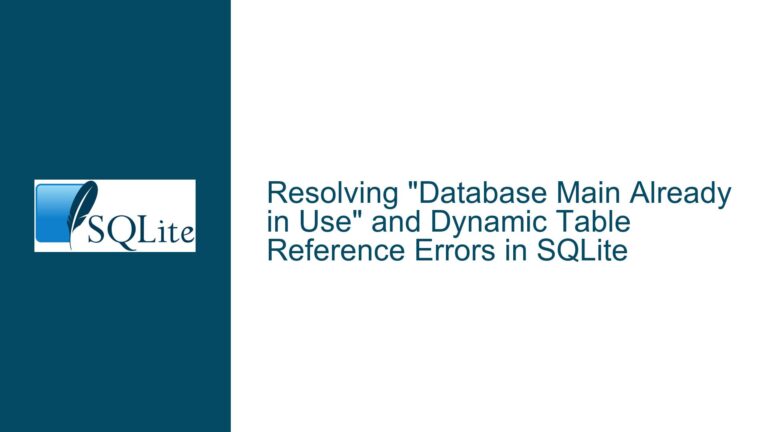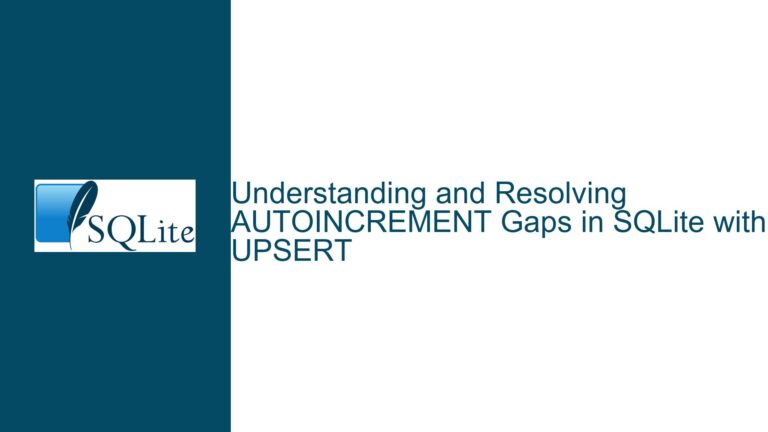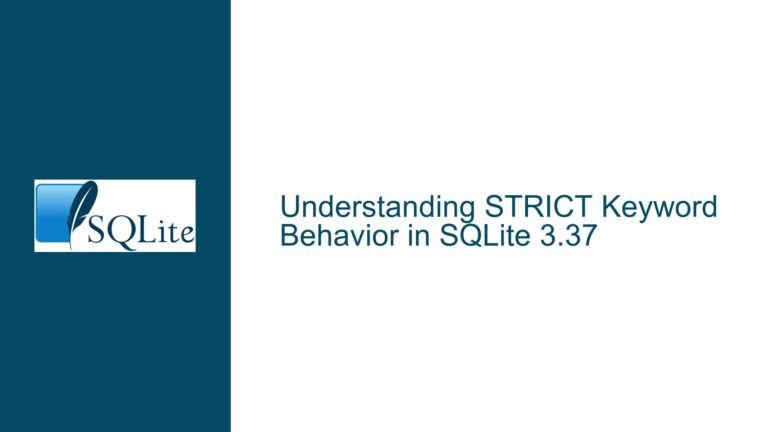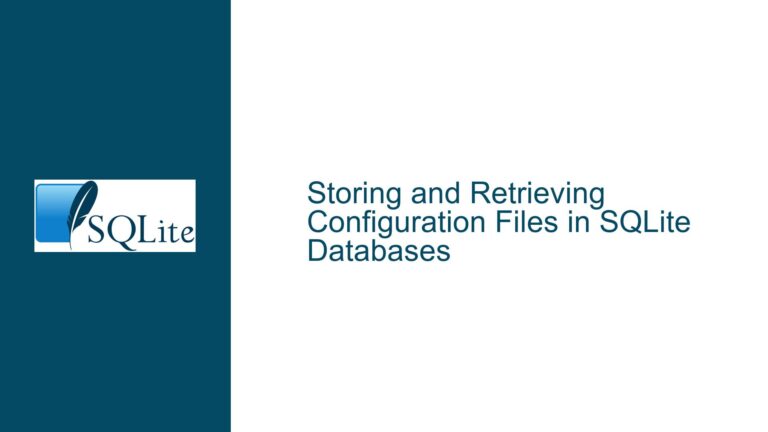Resolving Cascade Conflicts and Cyclical Foreign Key Dependencies in SQLite
Understanding Cascade Conflicts and Cyclical Foreign Key Dependencies
The core challenge arises when defining foreign key (FK) constraints with cascading delete/update actions in relational databases. This creates scenarios where a single row deletion/update triggers multiple cascading paths to the same target table or creates cyclical dependencies between tables. SQL Server explicitly blocks such configurations by default, while SQLite handles them with nuanced behavior that demands careful design consideration.
The Anatomy of Cascade Paths
A cascade path refers to the sequence of operations triggered by a DELETE or UPDATE action on a parent table. When child tables have FK constraints with ON DELETE CASCADE/ON UPDATE CASCADE clauses, deleting a parent row automatically deletes all dependent child rows. Problems emerge when multiple independent paths exist from a parent table to a child table. For example:
- Direct Path:
titles→books(viatitleidFK) - Indirect Path:
titles→divs→books(viadivs.titleidandbooks.dividFKs)
If both paths have cascading deletes, deleting a row in titles could attempt to delete the same row in books through two routes. SQL Server’s engine preemptively blocks this configuration due to ambiguity in execution order. SQLite, however, permits it but introduces operational subtleties.
Cyclical Dependencies and Race Conditions
Cycles occur when tables reference each other directly or indirectly through FKs with cascading actions. For example:
- Table A references Table B
- Table B references Table C
- Table C references Table A
In such cases, cascading operations could loop indefinitely. SQLite does not preemptively detect or block cyclical configurations, unlike SQL Server. Instead, it relies on runtime constraints and operational limits (e.g., maximum recursion depth) to prevent infinite loops.
SQLite’s Approach to Cascade Execution
SQLite processes cascading operations iteratively, layer by layer, until no more dependent rows exist. When multiple paths exist, the order of operations depends on table creation order and FK dependency hierarchy. This can lead to non-deterministic outcomes if not carefully managed. For instance, if books has two FKs to titles and divs, deleting a titles row might first delete divs rows, then books rows via divs.divid, followed by books rows via titles.titleid—or vice versa.
Root Causes of Cascade Conflicts in SQLite Implementations
1. Multiple Cascade Paths to the Same Table
When a child table has multiple FKs pointing to different parents, and those parents share a common ancestor, cascading deletes/updates can propagate through divergent paths. SQLite does not validate the number of cascade paths during schema creation. This contrasts with SQL Server, which enforces a strict single-path policy.
Example:
books.titleid→titles.titleid(ON DELETE CASCADE)books.divid→divs.divid(ON DELETE CASCADE)divs.titleid→titles.titleid(ON DELETE CASCADE)
Deleting a titles row cascades to divs and books via divs.titleid, while also cascading directly to books via books.titleid. This creates two deletion paths to books for the same titles row.
2. Absence of Cycle Detection at Schema Creation
SQLite does not perform cycle detection when defining FKs. Developers must manually ensure that their FK constraints do not create cyclical references with cascading actions. For example:
table1referencestable2with ON DELETE CASCADEtable2referencestable3with ON DELETE CASCADEtable3referencestable1with ON DELETE CASCADE
Deleting a row in table1 would cascade to table2, then table3, then back to table1, creating an infinite loop. SQLite terminates such operations after a predefined recursion depth (default: 1000), but this is a runtime check, not a schema validation.
3. Silent Handling of Ambiguous Cascade Order
SQLite processes cascading operations in the order tables are encountered during its traversal algorithm. This order is not guaranteed to be consistent or intuitive. For instance, if a row in titles is deleted, SQLite might first process deletions in articles, then divs, then books—or another permutation—depending on internal FK resolution logic. When multiple paths exist, the final state of the database depends on which path "wins" the race to modify the data.
Strategies for Managing Cascade Behavior and Preventing Data Integrity Issues
1. Explicitly Define Cascade Hierarchies
Avoid ambiguous cascade paths by designing a unidirectional hierarchy. For example:
- Parent Tables:
titles(root) - First-Level Children:
articles,divs - Second-Level Children:
books(dependent only ondivs, nottitles)
Revised Schema:
CREATE TABLE books (
bookid INTEGER PRIMARY KEY,
divid INTEGER NOT NULL,
name TEXT,
FOREIGN KEY (divid) REFERENCES divs(divid) ON DELETE CASCADE
);
Remove the books.titleid column to eliminate the redundant FK to titles. This ensures deletions from titles cascade only through divs to books, not directly.
2. Use Triggers for Controlled Cascade Logic
Replace ON DELETE CASCADE with AFTER DELETE triggers to manually control deletion order and conditions.
Example Trigger for titles:
CREATE TRIGGER cascade_title_deletion
AFTER DELETE ON titles
BEGIN
DELETE FROM articles WHERE titleid = OLD.titleid;
DELETE FROM divs WHERE titleid = OLD.titleid;
-- Books deleted via divs’ ON DELETE CASCADE
END;
Advantages:
- Explicit control over deletion order.
- Avoids unintended interactions between multiple FKs.
- Allows conditional logic (e.g., archive rows instead of deleting).
3. Leverage Composite Foreign Keys
If a child table must reference multiple parents, use composite keys to enforce dependency on a combined parent entity.
Example:
CREATE TABLE divs (
divid INTEGER PRIMARY KEY,
titleid INTEGER NOT NULL,
name TEXT,
UNIQUE (divid, titleid), -- Composite unique constraint
FOREIGN KEY (titleid) REFERENCES titles(titleid) ON DELETE CASCADE
);
CREATE TABLE books (
bookid INTEGER PRIMARY KEY,
divid INTEGER NOT NULL,
titleid INTEGER NOT NULL,
name TEXT,
FOREIGN KEY (divid, titleid) REFERENCES divs(divid, titleid) ON DELETE CASCADE
);
Here, books references both divid and titleid from divs, ensuring that deletions in titles propagate through divs without creating a separate path via books.titleid.
4. Implement Soft Deletes to Bypass Cascade Complexity
Replace physical deletes with logical deletes using a deleted flag column. This avoids cascade operations entirely.
Example:
ALTER TABLE titles ADD COLUMN deleted BOOLEAN DEFAULT 0;
CREATE INDEX idx_titles_deleted ON titles(deleted);
-- Querying active records:
SELECT * FROM titles WHERE deleted = 0;
Benefits:
- Eliminates the risk of cascade conflicts.
- Preserves historical data for auditing.
5. Validate Schema with Recursive Queries
Use recursive SQL queries to detect potential cycles or multiple cascade paths before they cause runtime errors.
Cycle Detection Query:
WITH RECURSIVE fk_graph AS (
SELECT 'titles' AS parent_table, 'divs' AS child_table
UNION ALL
SELECT 'divs', 'books'
UNION ALL
SELECT 'titles', 'books'
)
SELECT * FROM fk_graph
WHERE parent_table = child_table; -- Direct cycles
Path Counting Query:
WITH RECURSIVE fk_paths AS (
SELECT
child_table AS start_table,
parent_table AS end_table,
1 AS depth
FROM fk_graph
UNION ALL
SELECT
fk_paths.start_table,
fk_graph.parent_table,
fk_paths.depth + 1
FROM fk_paths
JOIN fk_graph ON fk_paths.end_table = fk_graph.child_table
)
SELECT start_table, end_table, COUNT(*) AS paths
FROM fk_paths
GROUP BY start_table, end_table
HAVING paths > 1; -- Multiple cascade paths
6. Enforce Foreign Key Constraints at Runtime
Ensure foreign key enforcement is enabled and configure operational limits:
PRAGMA foreign_keys = ON; -- Enable FK enforcement
PRAGMA recursive_triggers = ON; -- Allow nested trigger execution
Critical PRAGMA Settings:
foreign_keys: Must be enabled per-connection.recursive_triggers: Permits triggers to fire other triggers.
7. Monitor and Debug Cascade Operations
Use SQLite’s sqlite3_trace or logging extensions to capture the sequence of operations during cascades.
Example Debugging Output:
-- Deleting titleid=123
DELETE FROM titles WHERE titleid = 123;
-- Triggered: DELETE FROM divs WHERE titleid = 123;
-- Triggered: DELETE FROM books WHERE divid IN (456, 789);
-- Triggered: DELETE FROM articles WHERE titleid = 123;
Tools:
- SQLite CLI: Use
.traceto log queries. - Application-Level Logging: Log all DELETE/UPDATE operations.
8. Restructure Schemas to Isolate Cascade Paths
If multiple cascade paths are unavoidable, split tables into independent hierarchies.
Example:
- Hierarchy 1:
titles→articles - Hierarchy 2:
publications→divs→books
This separation eliminates cross-hierarchy FK references, reducing cascade ambiguity.
9. Use Deferrable Foreign Keys (When Supported)
While SQLite does not natively support deferrable constraints, you can emulate this behavior within transactions:
BEGIN TRANSACTION;
-- Disable triggers temporarily
INSERT OR DELETE ...;
-- Re-enable triggers and validate constraints
COMMIT;
Workflow:
- Disable triggers affecting cascade logic.
- Perform manual deletions/updates in a safe order.
- Re-enable triggers and commit the transaction.
10. Thoroughly Test Cascade Scenarios
Develop comprehensive test cases to validate cascade behavior under various conditions:
Test Case 1: Single Parent Deletion
DELETE FROM titles WHERE titleid = 123;
-- Verify: divs, articles, books related to titleid=123 are deleted
Test Case 2: Intermediate Table Deletion
DELETE FROM divs WHERE divid = 456;
-- Verify: books with divid=456 are deleted; titles remain
Test Case 3: Cyclical Reference Stress Test
-- If cycles exist (e.g., A→B→C→A), attempt to delete A
DELETE FROM A WHERE id = 1;
-- Expect: Termination after 1000 operations (default recursion depth)
Final Considerations
SQLite’s permissive approach to cascade paths offers flexibility but requires rigorous design discipline. By combining schema restructuring, trigger-based logic, and proactive testing, developers can harness the power of cascading FKs while mitigating risks of data corruption or unpredictable behavior. Always prioritize explicit data flow over implicit cascade chains, and validate complex dependencies early in the development cycle.






